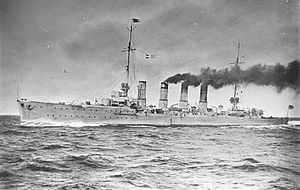Karlsruhe class cruiser

SMS Karlsruhe
|
|
| Class overview | |
|---|---|
| Builders: | Germaniawerft and Howaldtswerke |
| Operators: |
|
| Preceded by: | Magdeburg class |
| Succeeded by: | Graudenz class |
| Planned: | 2 |
| Completed: | 2 |
| Lost: | 2 |
| General characteristics | |
| Class and type: | Karlsruhe-class cruiser |
| Displacement: |
|
| Length: | 142.20 m (466 ft 6 in) |
| Beam: | 13.70 m (44 ft 11 in) |
| Draft: | 5.38 m (17 ft 8 in) |
| Installed power: | 26,000 shp (19,000 kW) |
| Propulsion: |
|
| Speed: | 29.3 kn (54.3 km/h; 33.7 mph) |
| Complement: |
|
| Armament: |
|
| Armor: |
|
The Karlsruhe class of light cruisers was a pair of two ships built for the German Imperial Navy before the start of World War I. The ships—SMS Karlsruhe and —were very similar to the previous Magdeburg-class cruisers, mounting the same armament and similar armor protection, though they were larger and faster than the earlier ships. Both vessels were laid down in 1911, and launched one day apart, on 11 and 12 November 1912. Karlsruhe joined the fleet in January 1914, but fitting out work lasted slightly longer on her sister; Rostock was commissioned the following month.
Both of the ships had short service careers. Karlsruhe was assigned to overseas duty in the Caribbean, arriving on station in July 1914, days before the outbreak of World War I. Once the war began, she armed the passenger liner SS Kronprinz Wilhelm so it could raid British shipping. After a moderately successful commerce raiding career, during which Karlsruhe sank sixteen merchant ships and successfully evaded British cruisers, she sank after an accidental internal explosion on 4 November 1914. Most of her crew were killed in the sinking, but the survivors returned to Germany on one of Karlsruhe's attendant colliers by December.
Rostock served as a torpedo boat flotilla leader with the High Seas Fleet following her commissioning; her flotilla frequently screened for the battlecruisers in the I Scouting Group, including during the Battle of Dogger Bank in January 1915 and operations off the British coast in early 1916. She saw heavy action during the Battle of Jutland on 31 May – 1 June 1916 as part of the screen for the main battle fleet. In the ferocious night fighting that occurred as the German fleet punched through the British rear-guard, Rostock was torpedoed by a British destroyer, which immobilized the ship. She was taken under tow by several torpedo boats, but early on the morning of 1 June, the cruiser HMS Dublin located the cruiser. To prevent her capture by the British, the Germans scuttled the ship after taking off her crew.
...
Wikipedia
